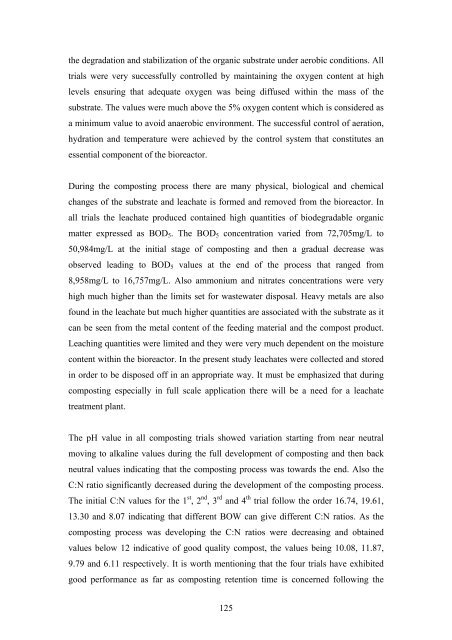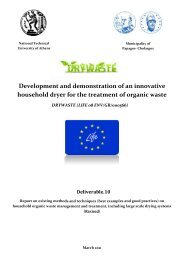MOROCOMP (LIFE TCY05/MA000141) - Unit of Environmental ...
MOROCOMP (LIFE TCY05/MA000141) - Unit of Environmental ...
MOROCOMP (LIFE TCY05/MA000141) - Unit of Environmental ...
Create successful ePaper yourself
Turn your PDF publications into a flip-book with our unique Google optimized e-Paper software.
the degradation and stabilization <strong>of</strong> the organic substrate under aerobic conditions. All<br />
trials were very successfully controlled by maintaining the oxygen content at high<br />
levels ensuring that adequate oxygen was being diffused within the mass <strong>of</strong> the<br />
substrate. The values were much above the 5% oxygen content which is considered as<br />
a minimum value to avoid anaerobic environment. The successful control <strong>of</strong> aeration,<br />
hydration and temperature were achieved by the control system that constitutes an<br />
essential component <strong>of</strong> the bioreactor.<br />
During the composting process there are many physical, biological and chemical<br />
changes <strong>of</strong> the substrate and leachate is formed and removed from the bioreactor. In<br />
all trials the leachate produced contained high quantities <strong>of</strong> biodegradable organic<br />
matter expressed as BOD 5 . The BOD 5 concentration varied from 72,705mg/L to<br />
50,984mg/L at the initial stage <strong>of</strong> composting and then a gradual decrease was<br />
observed leading to BOD 5 values at the end <strong>of</strong> the process that ranged from<br />
8,958mg/L to 16,757mg/L. Also ammonium and nitrates concentrations were very<br />
high much higher than the limits set for wastewater disposal. Heavy metals are also<br />
found in the leachate but much higher quantities are associated with the substrate as it<br />
can be seen from the metal content <strong>of</strong> the feeding material and the compost product.<br />
Leaching quantities were limited and they were very much dependent on the moisture<br />
content within the bioreactor. In the present study leachates were collected and stored<br />
in order to be disposed <strong>of</strong>f in an appropriate way. It must be emphasized that during<br />
composting especially in full scale application there will be a need for a leachate<br />
treatment plant.<br />
The pH value in all composting trials showed variation starting from near neutral<br />
moving to alkaline values during the full development <strong>of</strong> composting and then back<br />
neutral values indicating that the composting process was towards the end. Also the<br />
C:N ratio significantly decreased during the development <strong>of</strong> the composting process.<br />
The initial C:N values for the 1 st , 2 nd , 3 rd and 4 th trial follow the order 16.74, 19.61,<br />
13.30 and 8.07 indicating that different BOW can give different C:N ratios. As the<br />
composting process was developing the C:N ratios were decreasing and obtained<br />
values below 12 indicative <strong>of</strong> good quality compost, the values being 10.08, 11.87,<br />
9.79 and 6.11 respectively. It is worth mentioning that the four trials have exhibited<br />
good performance as far as composting retention time is concerned following the<br />
125










